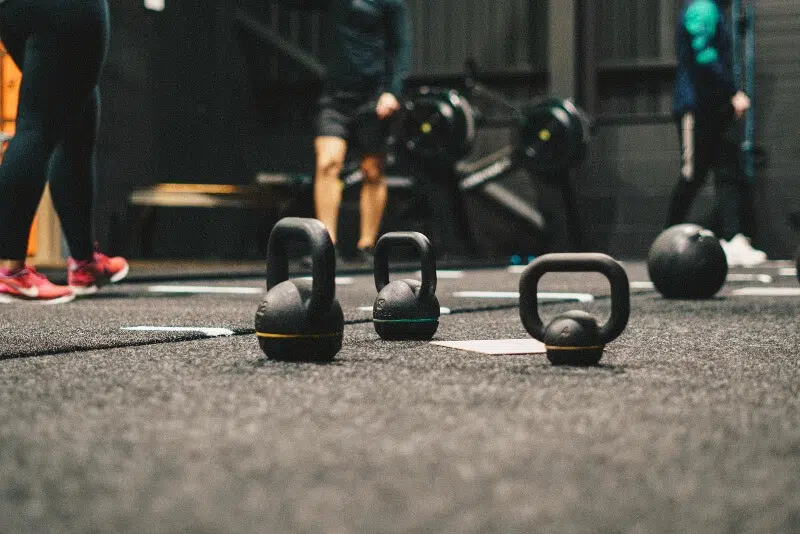There swimming is a sport that is already very complete. But practice bodybuilding alongside can be a very good way to further strengthen your muscles.
Thanks to bodybuilding, you will reduce the risk of muscle injuries and become faster in water. We tell you more in this article!
Bodybuilding & swimming, two complementary practices?
The answer is yes :
- There swimming allows you to combine overall muscle strengthening And cardiovascular work.
- There bodybuilding helps you to further strengthen the muscles stressed during swimming.
In the water water resistance works your muscles, much like weight training. However, the density of water always remains the same. While with the bodybuilding you can increase expenses.
It is precisely this aspect who gives the two complementary practices. The more you go work your muscles, the more you will be fast in the water.
How ? Because by producing more strength when you swim, you are faster.
With more strength, you combat water resistance more easily and you therefore gain speed.
This is why strength training helps you improve your swimming performance and speed in water.
And yes, it's not for nothing that high-level swimmers do bodybuilding alongside their swimming sessions!
Is it possible to build muscle through swimming?
To build muscle with swimming, you must repeat lengths with a sustained intensity. And to have a high intensity, nothing better than the sprints and the split.
For progress further and tone your muscles, you can also :
- Adapt And vary your workouts.
- Make specific exercises swimming.
The different muscles strengthened by swimming
Each swimming strengthens the muscles differently. Moreover, all swims do not solicit not the same muscles. Here is a small list to guide you:
- To strengthen your muscles back, swim it crawl and the backstroke.
- For the shoulders and the triceps, opt for the crawl and the butterfly.
- For the pectorals and the biceps, swim it breaststroke.
- For the abs, alternate crawl, backstroke And butterfly.
- For the glutes, there breaststroke is the best option.
- For the thighs and the calves, swim it crawl and the backstroke.
To find out more on the subject, we invite you to read our article on the muscles used by swimming. 👀
How to combine bodybuilding and swimming?
The goal is not to promote bodybuilding, but to practice it in addition to swimming. For this, you must distribute your sessions well.
You can obviously do both, but the best is to avoid to do your session swimming and of bodybuilding THE same day. You need to give your body time to recover properly.
That's why it's good to alternate swimming and weight training every other day. For example, you can start with a total of 5 sessions with 3 swimming sessions And 2 bodybuilding :
- A day swimming
- A day bodybuilding (upper body)
- A day swimming
- A day bodybuilding (lower body)
- A day swimming
You can of course take one or two days of rest between the different sessions. Do as you feel!
For your bodybuilding sessions you can go on circuit training. YOU chain together several exercises without much (or any) rest.
For example, you can make 8 exercises in a circuit. The goal of circuit training is to complete the circuit several times.
At the end of a few weeks of training (by being regular), you will quickly be able to benefit from the benefits strength training for swimming!
7 Steps to Preparing Your Strength Training Program for Swimming
To make your task easier, we have prepared a small list of 7 tips to follow to create your own training plan :
- Set yourself some goals in relation to your swimming practice.
- Choose the distribution swimming/weight training that suits you best.
- Define the duration of your program training.
- Select your exercises.
- Find it number of sets and repetitions.
- Make sure to increase workloads step by step.
- Test your program and adjust it.
Building your own training program remains quite complicated. So, don't hesitate to ask for help to a sports coach or a swimming instructor.
The benefits of strength training for swimming
Your weight training sessions will be beneficial for your swimming workouts, because they will allow you to:
- To struggle against and or avoid THE muscle imbalances.
- Improve your weak points.
- Have a better physical condition.
- To strenghten more your muscles and your sheathing.
- Win in power and in explosiveness for more speed in water.
- Develop a better support and an best swimming posture.
- Strengthen your support to be more efficient in your movements.
- Reduce the risk of muscle injuries in water.
- Solicit of the unengaged muscles during the swimming.
Some strength training exercises for swimming
There Golden Rule to apply before embarking on the different exercises is the following: always warm up for at least 5 minutes.
This allows to prepare your body for exercise, of warm up your muscles and of reduce the risk of injury.
Once you are well warmed up, you can move on to the exercises. You have several options:
- Exercises to do indoors with rod, dumbbells Or machines.
- Exercises to do at home with some elastic or to body weight.
Some exercises to do with elastics
- Spread with elastic (one arm or two arms) for the pectorals
- Extension (or press-down) for the triceps
- Pullover (one arm or two arms) for the back
- Front and lateral (one-arm) shoulder raises
- Rowing (one or two arms) for the back
Some bodyweight strengthening exercises
- Dynamic sheathing on the back, sides, elbows and hands
- Push-ups (with elastic to add more resistance)
- Traction (with elastic for ease)
- Squats and jump squats
- Mountain climbers
- Lunges and side lunges
- Burpees
- Flutter kicks (scissors)
- Russian twists
Some exercises to try in the gym
- Butterfly (machine)
- Spread (dumbbells or pulley)
- Pullover (dumbbells or pulley)
- Vertical and horizontal draw (machine)
- Bench press (dumbbells or barbell)
- Deadlift (barbell or dumbbells)
There is of course a multitude of other exercises to do, but these will be very useful for swimming!
There second golden rule to apply is the following: If an exercise hurts or bothers you, don't hesitate to adapt it or change the exercise.. There's no point in forcing yourself if an exercise is painful.
Now that you have a few exercises to try, we can talk to you about main muscles to strengthen and how to go about it.
Muscles to strengthen and how to strengthen them
Depending on the stroke, it is not necessarily necessary to concentrate on all the muscles. However, to avoid injuries, It would be better strengthen all muscle groups.
In your training, think about to work both the antagonistic muscles And agonists. Muscles the most importants to be strengthened are above all the back, THE lumbar and the abdominal strap.
Then you can also focus on the shoulders, THE pectorals, THE triceps, etc.
Strengthen your back
The back, but especially the latissimus dorsi, is the upper muscle motor in swimming.
Your back participates a lot in the force production allowing you to move forward in the water. It comes into play in all pulling movements.
Exercises to strengthen the latissimus dorsi
- Pull-ups
- The sweater
- The vertical draw
Strengthen your abdominal strap
Your abs stabilize your body and help you to have a best position in the water. Hence the importance of strengthening them.
With a well-sheathed trunk, your position is more hydrodynamic and your movements are therefore more efficient.
THE sheathing is equally important, because it ensures force transfer. Particularly between the propulsion from your movements and the movement of your body.
Exercises to tone your abs
All exercises that use your abdominal muscles are interesting. Here are some examples :
- Ventral sheathing, on the back, on the sides, on the hands, on the elbows
- Dynamic cladding
- Russian twists
- Bicycle crunch
Tone your shoulders
The shoulder is the most used joint in swimming, especially when swimming front crawl and backstroke.
It comes into play in what is called aerial recovery phase. That's to say when you bring your arm back.
It's a very mobile joint, so very unstable. The shoulders are also often subject to injuries. This is why it is important to strengthen them.
Exercises to strengthen your shoulders
- Internal and external rotations
- Lateral, frontal and posterior elevations
- Shoulder press
- Sweater face
Strengthen your triceps
The triceps is a muscle essential in every pushing movement. Especially for finish the push in front crawl, backstroke and butterfly.
Located opposite your biceps, it allows you to finish the pushing movement up to your hip.
Exercises to tone your triceps
- Tricep extension
- Bar on the forehead
- Close grip bench press
- Dips on a bench
Strengthen your pectorals
A bit like your abs, the pectorals allow you to stabilize your movements when you swim the front crawl.
They do not necessarily provide force for propulsion, but give strength in pulling.
Exercises to strengthen your pectorals
- Pumps
- Bench
- Dips
- Spreads (dumbbells, pulley or elastic)
Tone your quads
Located at the front of your thighs, they make it easier to flex your thigh on your hip. Basically, it's when your knee rises to the height of your hip.
Your quadriceps are engaged when you do a knee bend. No matter the swim, they are in demand.
Exercises to strengthen your quadriceps
- Squats
- Slots
- Leg extension
- Leg press
THE best way to work the quadriceps (and other lower body muscles) for swimming remains to do plyometric exercises.
What is a plyometric exercise? A plyometric exercise is a two-part exercise that helps you gain strength, agility and endurance.
The two phases are:
|
Plyometric exercises are ideal to gain explosiveness, in strength and in speed. For example, you can try the sautéed lunges where the jump squats.
In conclusion
Practicing weight training in addition to swimming can only benefit you. By further strengthening your muscles, you will reduce the risk of injury while gaining explosiveness and therefore in speed in water.
With a good workout program, and an good distribution your swimming and weight training sessions, you will quickly see a difference when you swim!
Does bodybuilding mean nothing to you? Test the aquabike!
Just like bodybuilding, aquabike is a very good complementary sport to swimming.
You don't know the concept? Nothing complicated: you pedal on a bike immersed in the water of a swimming pool.
Perfect for strengthen your legs, your abs and improve your cardio, aquabike is just as gentle on your joints than swimming.
Aquabike at Aqua by
At Aqua by, we offer you (re)discover aquabike differently. Various sessions (aquapalming, performing, etc.) are offered to you in order to vary the pleasures and make the practice more fun !
Our coaches are waiting for you, so book your first session And take the plunge in our studios located in Paris and Boulogne. 💦





